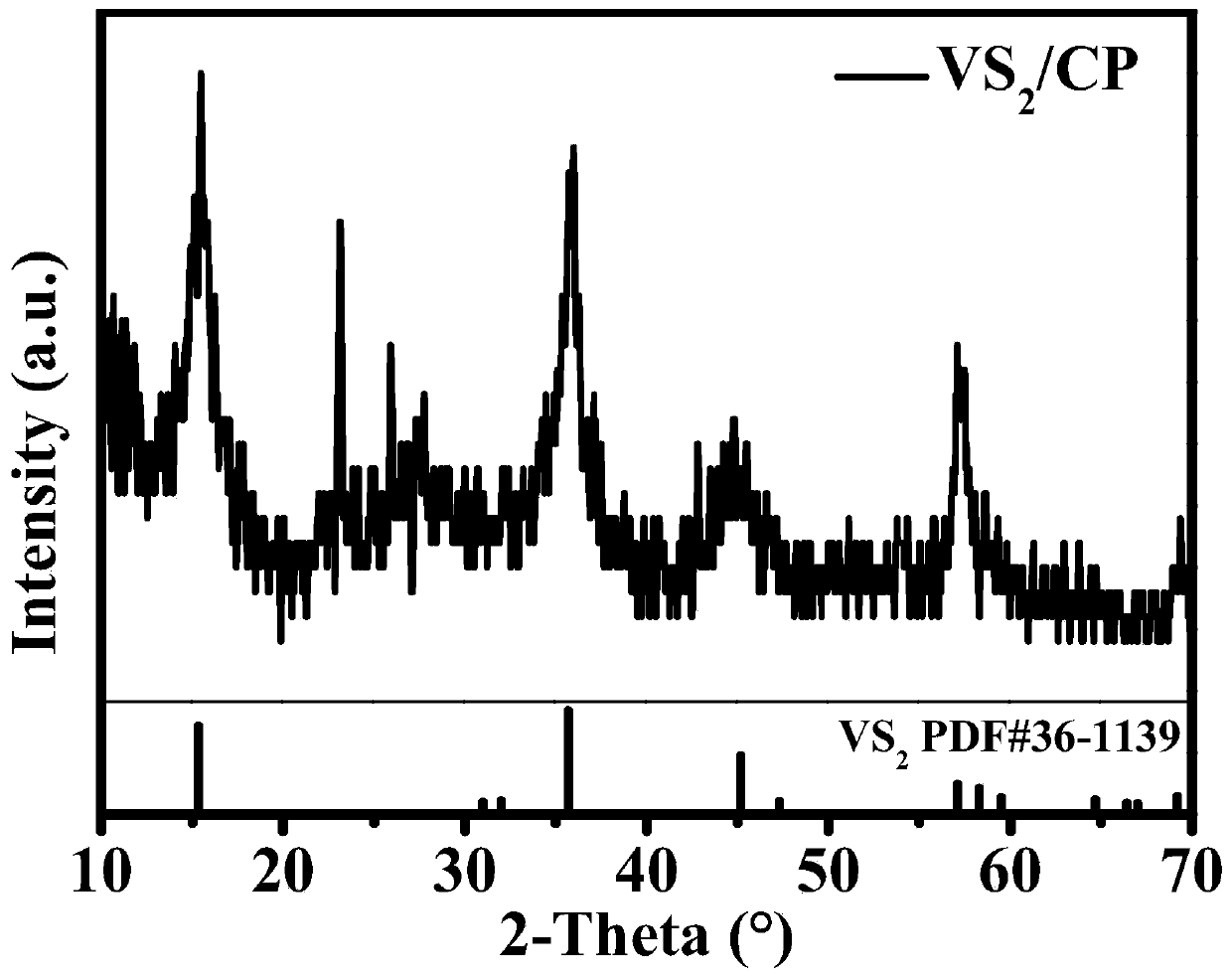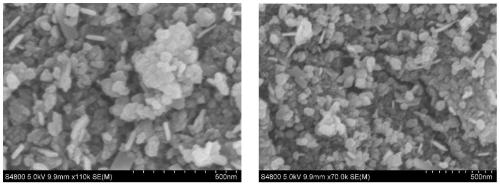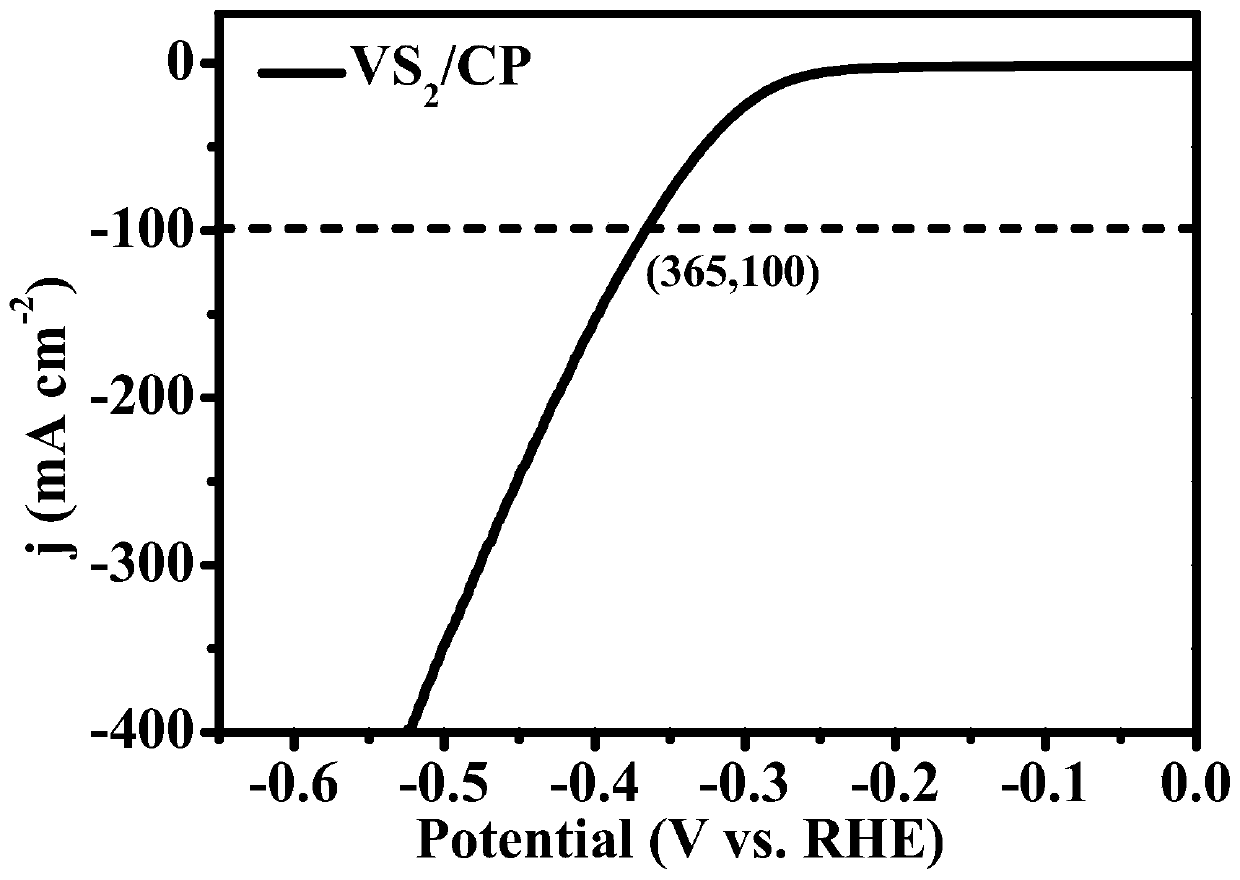Preparation method of round cake-like vanadium disulfide electrocatalyst
A vanadium disulfide, electrocatalyst technology, applied in physical/chemical process catalysts, chemical instruments and methods, electrodes, etc., can solve problems such as high cost and electrochemical application limitations, and achieve low synthesis temperature, simple synthesis route, raw materials Inexpensive and accessible effects
- Summary
- Abstract
- Description
- Claims
- Application Information
AI Technical Summary
Problems solved by technology
Method used
Image
Examples
Embodiment 1
[0029] 1) Sonically clean the carbon paper in pure acetone solution for 5 minutes, then immerse the carbon paper in 3mol / L hydrochloric acid for 5 minutes, and finally wash it with ethanol and deionized water alternately for 3 times, and dry it in vacuum at 25°C for 15 hours to obtain Treated carbon paper;
[0030] 2) Press NaVO 3 :C 2 h 5 The molar ratio of NS is 1:5 to NaVO 3 and C 2 h 5 NS was added to 15ml ethanol at the same time and magnetically stirred at room temperature for 30min to obtain a clear solution A with a vanadium source concentration of 0.051mol / L;
[0031] 3) Pour the carbon paper and solution A treated in step 1) into the reaction liner to seal, install the reaction liner in the outer kettle and fix it, then place it in a homogeneous reactor for hydrothermal reaction at 160°C for 18 hours;
[0032] 4) After the hydrothermal reaction, the reactor was naturally cooled to room temperature, and the carbon paper was taken out and washed alternately with ...
Embodiment 2
[0034] 1) Sonically clean the carbon paper in pure acetone solution for 10 minutes, then immerse the carbon paper in 2mol / L hydrochloric acid for 10 minutes, and finally wash it with ethanol and deionized water alternately for 4 times, and dry it in vacuum at 35°C for 14 hours to obtain Treated carbon paper;
[0035] 2) Press NaVO 3 :C 2 h 5 The molar ratio of NS is 1:6 to NaVO 3 and C 2 h 5 NS was added to 15ml ethanol at the same time and magnetically stirred at room temperature for 40min to obtain a clear solution A with a vanadium source concentration of 0.08mol / L;
[0036] 3) Pour the carbon paper and solution A treated in step 1) into the reaction liner to seal, install the reaction liner in the outer kettle and fix it, then place it in a homogeneous reactor for hydrothermal reaction at 180°C for 20 hours;
[0037] 4) After the hydrothermal reaction, the reactor was naturally cooled to room temperature, and the carbon paper was taken out and washed alternately with...
Embodiment 3
[0039] 1) Sonically clean the carbon paper in pure acetone solution for 15 minutes, then immerse the carbon paper in 4mol / L hydrochloric acid for 10 minutes, and finally wash it with ethanol and deionized water alternately for 3 times, and dry it in vacuum at 40°C for 12 hours to obtain Treated carbon paper;
[0040] 2) Press NaVO 3 :C 2 h 5 The molar ratio of NS is 3:13 to NaVO 3 and C 2 h 5 NS was added to 20ml ethanol at the same time and magnetically stirred at room temperature for 45min to obtain a clear solution A with a vanadium source concentration of 0.1mol / L;
[0041] 3) Pour the carbon paper and solution A treated in step 1) into the reaction liner to seal, install the reaction liner in the outer kettle and fix it, then place it in a homogeneous reactor for hydrothermal reaction at 160°C for 20 hours;
[0042] 4) After the hydrothermal reaction, the reactor was naturally cooled to room temperature, and the carbon paper was taken out and washed alternately with...
PUM
 Login to View More
Login to View More Abstract
Description
Claims
Application Information
 Login to View More
Login to View More - R&D
- Intellectual Property
- Life Sciences
- Materials
- Tech Scout
- Unparalleled Data Quality
- Higher Quality Content
- 60% Fewer Hallucinations
Browse by: Latest US Patents, China's latest patents, Technical Efficacy Thesaurus, Application Domain, Technology Topic, Popular Technical Reports.
© 2025 PatSnap. All rights reserved.Legal|Privacy policy|Modern Slavery Act Transparency Statement|Sitemap|About US| Contact US: help@patsnap.com



